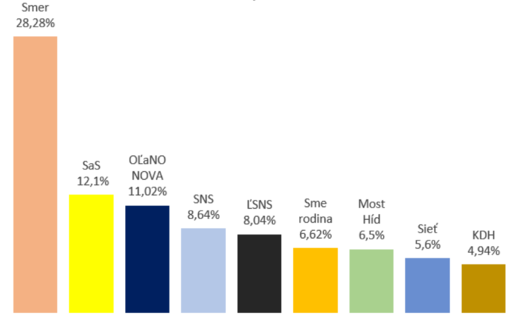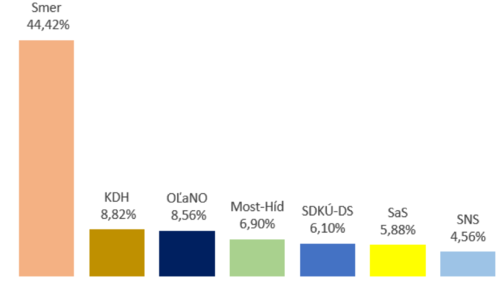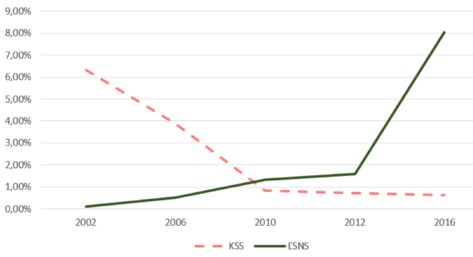An analysis of the outcome of the 2016 Slovak parliamentary elections. What were the expectations beforehand, what actually happened and what does this mean for the Slovak and European left?
Pre-election expectations
Post-election surprises had not been expected. Opinion polls, Slovak and foreign media as well as political scientists predicted the lower but decisive number of votes for the ruling party.
There had been discussions particularly about the future government of the Smer-Social Democracy party (Smer-SD), which was supposed to be influenced especially by voter preferences for the Slovak National Party (SNS), the Christian Democratic Movement (KDH) and the Network (Sieť). There was also a hope for the right-wing parties to form a “conglomerate” – the pejorative term that was introduced by Fico in order to refer to a coalition of parties with different political values but the common goal to rule the country.
In fact, the opposition had been thought to gain slightly stronger support at the expense of the ruling party. However, the election results showed a completely different reality.
Results
Smer-SD took fewer votes than expected. While in the 2012 elections it gained 44.41 percent of the votes, in the 2016 elections it plunged below 30 percent (28.28 percent of the votes). On the other hand, the liberal Freedom and Solidarity (SaS) jumped from 6.6 percent to 12.10 percent and the conservative OĽaNO (Ordinary People and Independents) took 11 percent of the vote in comparison to the previous 8.55 percent. The Slovak National Party (SNS) was particularly successful. It returned to the parliament after a four-year-absence with 8.64 percent.
Before the elections, hardly anybody would have expected that one of the most stable political parties – the Christian Democratic Movement (KDH) would not get enough votes to be represented in the parliament. However, there were more surprises. Sieť, which had been deemed to be the strongest right-wing party, barely crossed the threshold to win seats with only 5.6 percent of the vote. Members of the Bridge party (Most-Híd) had also expected a better result than just 6.5 percent.
On the other hand, the millionaire Boris Kollár, who is well-known for having nine children with eight different women, is satisfied with the election results. He called his party an apt name – We Are Family (Sme Rodina). Even though he had founded it only four months before the elections, it took 6.6 percent of the vote.
Finally, I would like to mention the biggest shock of these elections. In 2016, for the first time since 1945, the parliamentary seats will be reserved for the party the members of which openly express their sympathy for Adolf Hitler and the Slovak Nazi-puppet state as well as their racist and xenophobic opinions. The People’s Party – Our Slovakia (ĽSNS) took 8 percent, which is not a negligible number.
Comparison of the Slovak 2016 parliamentary elections with the results of 2012 elections
2016 elections:

2012 elections:

What has actually happened?
The pre-election polls did not produce accurate results due to a high percentage of the voters who decided at the last minute and the fortnight moratorium on opinion polls prior to the election. The strong voters’ support for ĽSNS might have been caused also by the fact that its voters were not willing to express their preferences in pre-election polls.
Most of the political analysts agree that the significant drop in support for the ruling party and the increase in support for its biggest critics (SaS and OĽaNO-NOVA) have been brought about by the following reasons:
- The government has paid more attention to the migrant crisis than the domestic policy.
- There was a difference between the achievements the government had presented, the economic and social indicators and their real impact on the population.
- The government has had apparently stronger relations with entrepreneurial strata than with ordinary people.
The prime minister personally talks about the fatigue of political material (he has won the elections for the third time in a row). The pre-election campaign, which included also anti-government protests of teachers and nurses, had an impact on the results as well.
According to analysts, there are several reasons why the non-standard parties, especially ĽSNS, fared well in the election. First and foremost, they point to vast regional differences and the unemployment rate, which is still higher than 10 percent. However, some districts struggle with the unemployment rate higher than 20 percent. Opinion polls show that voters have lost their trust in the standard parties since they are not capable of solving their problems. When we look at the reasons why ĽSNS has got to parliament, we can see the worrying reality regarding the level of knowledge of history that the Slovak youth has. It is unsatisfactory partly due to underestimation of fascism and its atrocities in the learning process.
This worrying reality, frustration of the Slovak voters, the low standard of living in poorer regions and natural inclination of young people toward radical solutions partially explain the incomprehensible support for ĽSNS in the villages whose inhabitants became victims of the most brutal massacres in the entire history of the Slovak nation that took place during Word War II. One example is the village of Ostrý Grúň which anti-partisan units burned down in January 1945 after murdering the most of its inhabitants, including children and women. In this village, ĽSNS won almost 17 percent of the vote, which is twice as many as the average result in the elections.
View from the left
A critical look at the political spectrum of the new Slovak parliament firstly reveals the absence of a left-wing political party. Smer-SD cannot be regarded as such a party even though it promotes the strongest social agenda of all the political parties. Firstly, it is because it prefers pragmatic and populist strategies to implementation of a clear pro-social policy. Secondly, it is because this party is shifting considerably from its centre-left orientation after striking a deal with Most-Híd and Sieť to form a coalition- “conglomerate”, which Fico had been mocking bitterly before he joined one.
A more radical left-wing party last won the seats in the 2002 parliamentary elections. At least the Communist Party of Slovakia, which took 6.33 percent of the vote, was considered to be far left-wing. Today, it is a marginal political party controlled by a few irremovable individuals. In the past 14 years, they have intentionally managed to reduce the party’s membership from 22,000 to 1,000 members, most of whom have reached the retirement age. Furthermore, the party’s leaders have successfully dissolved the youth organisation.
This issue, which seems to be an internal matter of one political party at first glance, has a considerable impact on the Slovak society: communists used to have a well organised and broad membership which could fulfil not only political but also social, educational and cultural roles, particularly in poorer regions. Its reduction means that this vast area with hundreds of thousands of frustrated people is now lying in the hands of fascists.
Election results of KSS and ĽSNS:

Is improvement possible?
From a medium-term perspective, the improvement is certainly not possible. It is hard to be optimistic even in the long run. The post-election state of affairs is the result of the long-term badly arranged political, educational and value system. It is the system which gives the biggest chance for political entrepreneurs and criminals to get to parliament. This system allows students to mistake the Holocaust for tree cutting and to associate the name of the president of the Slovak fascist state with football. Furthermore, it is this system that teaches young people to read and count but it does not explain the reasons and consequences of poverty and deep economic and social differences between people in general.
Unless there is some political power capable of changing this system, our society will witness the reality in which extreme rightists will gain more power since voters will get more and more frustrated with the standard political parties which lack interest to solve their problems.